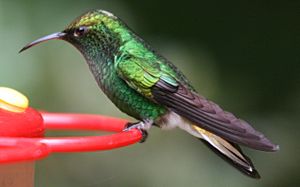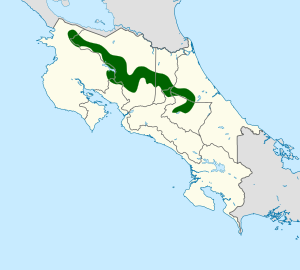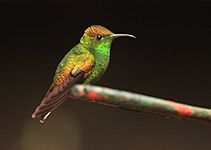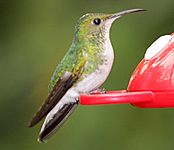Coppery-headed emerald facts for kids
Quick facts for kids Coppery-headed emerald |
|
|---|---|
 |
|
| Conservation status | |
| Scientific classification | |
 |
|
| Range of M. cupreiceps |
The coppery-headed emerald (Microchera cupreiceps) is a tiny, shiny hummingbird. It belongs to a group of hummingbirds called "emeralds." This special bird is only found in Costa Rica.
Contents
About the Coppery-Headed Emerald
What Does It Look Like?
The coppery-headed emerald is about 7.5 cm (3.0 in) long. It weighs around 3.0 to 3.3 g (0.11 to 0.12 oz), which is about the same as two paper clips! Both male and female birds have a slightly curved beak. The lower part of their beak is often pinkish at the base.
The adult male has a dull coppery bronze color on its head. Its neck, back, and rump are bronze-green. The feathers covering its upper tail are a bright coppery bronze. The two middle tail feathers are bronze. The next three pairs are white with light gray tips. The very outer pair of tail feathers are white with black tips. Its belly and chest are a bright yellowish metallic green. The feathers under its tail are white. Some males in the northern Cordillera de Guanacaste even have a purple spot on their chest!
The adult female has metallic green upper parts. Her upper tail feathers are bright, somewhat coppery bronze. Her middle tail feathers are bright bronze. The next three pairs are white with a gray or dark bar near the end. The outer pair is white with gray or dark tips. Her belly is dull white to grayish white, becoming pure white near her vent area. She also has metallic green spots along her sides.
Young males look similar to adult females but are duller. They have black tips on all their tail feathers, except for the central pair.
Where Do They Live?
The coppery-headed emerald lives in the high mountains of northern and central Costa Rica. Most of the time, you can find them on the Caribbean side of the mountains. But in the far north, they also live on the Pacific side.
They like to live at the edges and inside moist, humid mountain forests. Inside the forest, males often stay high up in the treetops. Females are usually found lower down, in the understory. However, both can be seen at all levels near the forest edges or in open areas like clearings. They live at different heights depending on the side of the mountain. On the Caribbean side, they are found from 300 to 1,500 m (980 to 4,900 ft) high. On the Pacific side, they are usually not found below 1,200 m (3,900 ft).
How Do They Behave?
Moving Around
After they finish breeding, coppery-headed emeralds move to lower parts of the mountains.
Finding Food
The coppery-headed emerald drinks nectar from many different kinds of flowering plants, shrubs, and trees. Some examples include plants from the Besleria, Cavendishia, Clusia, Guarea, Pithecellobium, Quararibea, Satyria, and Inga groups. Besides nectar, they also pick up small insects from leaves. They can also catch insects in the air while flying from a perch.
Family Life
The breeding season for the coppery-headed emerald is from October to March. This time might change a little each year. Male birds gather in small groups at special spots to attract females. They sing from a perch and chase other males away.
Female birds build a small cup-shaped nest. They use plant fluff and scales from tree ferns, holding it all together with spiderwebs. They might add some moss and lichen on the outside. The nest is usually placed between 1 and 3 m (3 and 10 ft) above the ground. It's often in the understory or along the edge of the forest. Females usually lay two eggs. We don't know exactly how long it takes for the eggs to hatch or for the chicks to be ready to fly.
Their Calls
The coppery-headed emerald's song is described as "high, thin, twittering and warbling." Its call sounds like "a high, thin, liquid quip or quit" or a "rapid high sputtering" when they are chasing each other.
Are They Safe?
The IUCN (International Union for Conservation of Nature) says the coppery-headed emerald is a species of "Least Concern." This means they are not currently in danger of disappearing. There are at least 20,000 adult birds, and their numbers seem to be stable. No immediate threats have been found. This hummingbird is considered quite common and lives in many protected areas.
Gallery
See also
 In Spanish: Esmeralda capirotada para niños
In Spanish: Esmeralda capirotada para niños





